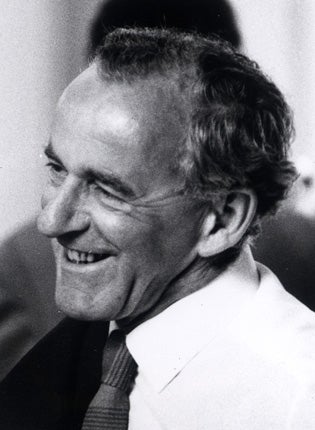Gordon Michell: Architect and conservationist celebrated for his work in the field of urban regeneration

Gordon Michell will be remembered best for his work in the field of urban regeneration, for which he was appointed OBE in 1985, but during his long and distinguished professional career he played an important role in a number of influential projects.
After war service in Normandy, Germany and the Middle East, Michell returned to the Architectural Association and graduated in 1948 with an honours diploma. Scholarships enabled him to travel in Italy, Spain, Europe and the United States, studying townscape, historic buildings and the architecture of road transport. He and his wife, Eleanor, set up their architectural practice, Michell & Partners, in 1954. His work included innovative bank design, housing (notably in Cirencester) and urban landscaping, but Michell was also drawn to the wider environment. In 1962 he was asked to join Colin Buchanan's study group, resulting in the production of the ground-breaking report Traffic in Towns. He was thus a party to the appropriation of the word "environment" from its exclusive use by biologists to the invention of the "environmental area" – and from there to its present use.
It was as a partner of Buchanan that Michell was responsible for the Bath Conservation Study, one of many city conservation studies which helped to establish urban conservation as a mainstream planning discipline.
He became consultant architect to the Civic Trust in 1973 and played a leading part in the Trust's role as UK secretariat for European Architectural Heritage Year in 1975. He was also architectural advisor to the newly established Architectural Heritage Fund, to The David Knightly Charitable Trust and to the Historic Buildings Council for the administration of grants within "non-outstanding conservation areas". In those roles he became the friend, supporter and advisor of numerous amenity societies and building preservation trusts up and down the country.
While with the Civic Trust he set up and led the award-winning Wirks-worth Project. Michell identified the small Derbyshire market town of Wirksworth as being a suitable subject for an experimental project funded by the Sainsbury family's Monument Trust. Simon Sainsbury wanted to see if community-led conservation could be used as an engine for urban regeneration. This now sounds commonplace, but in 1977 it was a groundbreaking concept. It was Michell's great humanity, as well as his professional skills, which led to the success of the Wirksworth Project, described by Prince Charles in a speech to the Institute of Directors as "brilliantly innovative". The project won the 1982 Europa Nostra Medal for architectural conservation and the 1984 Royal Town Planning Institute Award for Planning Achievement.
It is easy to fall into the trap of hagiography when writing of someone after their death, but Michell did indeed have some spiritual qualities. All who knew and worked with him came under his spell. He was a most gentle man. Nevertheless, he was a perfectionist with a core of steel and totally dedicated to any task in hand. Anyone working with him could be sure that if the telephone rang at 11.30 at night it would be Michell at the other end, oblivious of the time.
Michell had a very good "eye" and used this talent with impressive results in the medium of photography. His work, which was in the school of Eric de Maré, whom he had known, dealt with buildings in the urban and rural landscape. He devoted increasing amounts of time and energy to black and white photography as an art form and a major exhibition of his work was held at the Architectural Association in 1995.
In 1983 the chairman of the Royal Fine Arts Commission, Lord St John of Fawsley (then Norman St John-Stevas), commissioned Michell to write a book to encourage better design of town centres. Design in the High Street was illustrated with Michell's own photographs. In 1993 he collaborated with Barry Joyce and Mike Williams in the production of a picture book Derbyshire: Detail and Character. For every one of the 150 of Michell's black-and-white photographs published, there were another nine unused, a consequence of his perfectionist approach, as he revisited each location several times until conditions were right.
Although not a performer, classical music was an integral part of his life and his home was full of music.
In the later years of his life he suffered from increasingly difficult illnesses. He survived these not just with stoicism but as part of a life that was still interesting, fun and very much worth living. He died in hospital in the early hours of the morning after a fall at his house the previous evening.
He is survived by his wife and partner, Eleanor, his daughter, two sons and grandchildren.
Barry Joyce
Gordon Michell, architect, urbanist, conservationist and photographer: born 9 June 1923; OBE 1985; married Eleanor (two sons, one daughter); died 10 November 2009.
Join our commenting forum
Join thought-provoking conversations, follow other Independent readers and see their replies
Comments